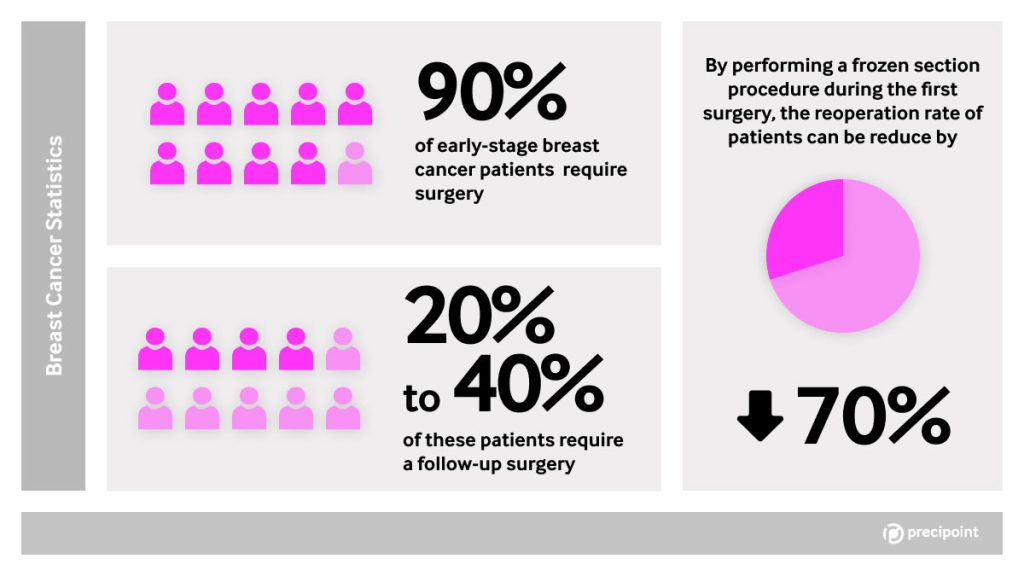Breast cancer is the most common cancer among women in Germany. The treatment of breast cancer patients often requires not only one, but several surgical procedures. These are extremely uncomfortable and risky for patients. Studies have shown that intraoperative frozen section examinations can significantly reduce reoperation rates. However, these analyses are not currently part of standard practice in surgical breast cancer therapy. Digitization can increase the availability of intraoperative examinations and thus indirectly contribute to improved care for breast cancer patients.
How common is breast cancer among women in Germany?
About 30 percent of all cancer patients in Germany have breast cancer. More than 90 percent of all women diagnosed with early breast cancer require surgery. 20 to 40 percent of these patients require at least one additional operation to completely remove the tumor-positive marginal tissue.
Follow-up surgeries are always associated with inconvenience and risks for patients and lead to delays in subsequent radiation and other supportive therapies. In addition, they provide increased costs for the healthcare system.
Stay Ahead with Insights from Precipoint!
Welcome to our newsletter! Be the first to know about our latest products, services, webinars, and happenings in PreciPoint. Don't miss out on this opportunity to stay informed. Subscribe to our newsletter today!
By clicking “Subscribe”, you agree to our privacy policy.
To what extent can intraoperative histopathological examinations reduce follow-up surgeries?
Intraoperative pathological examinations can significantly reduce the rate of reoperations in breast cancer therapy. Studies show that in breast cancer, frozen section procedures have reduced the rate of subsequent surgeries by 70 percent, from 48.9 percent down to 14.9 percent.
Objective of Intraoperative Examination
The main objective of the intraoperative examination is to provide the operating surgeon as quickly as possible with information that will allow him to decide on the further course of the operation. For this purpose, the pathologist usually uses the so-called frozen section procedure, in which the tissue is shock-frozen, sectioned, stained, and evaluated under the microscope. This examination should not take longer than 15 to 20 minutes, as during this time the patients are kept under anaesthesia. Thus, intraoperative consultations allow the surgeon to resect additional breast tissue or perform axillary lymphonodectomy (cALND) during the initial breast cancer surgery.
Time Constraints and Importance of Prompt Diagnosis
This examination should not take longer than 15 to 20 minutes, as during this time the patients are kept under anesthesia. Thus, intraoperative consultations allow the surgeon to resect additional breast tissue or perform axillary lymphonodectomy (cALND) during the initial breast cancer surgery.

Why are intraoperative frozen section examinations not yet common practice in breast cancer surgery?
However, intraoperative frozen section analysis of margins is not currently a common practice in patients undergoing breast-conserving therapy. Many institutions cannot offer intraoperative analysis of lumpectomy specimens as a standard, much less frozen section examination of resection margins for these specimens. This is mainly due to the limited local availability of pathologists and limitations in standard frozen sectioning techniques.
How can breast cancer treatment be improved?
Digitization of intraoperative examinations can indirectly contribute to improved care for cancer patients. It increases the availability and feasibility of intraoperative consultations: For example, remote consultations can allow remote specialists to collaborate during consultations ( > read more on the topic in our article: 3 Reasons Why Pathologists May Seriously Consider Digitizing Intraoperative Consultations ). This can further optimize patient care and treatment approaches and improve treatment outcomes.

With the new iO:M8 ROSE, PreciPoint offers you a distinct solution for the digitalization of intraoperative examinations in cancer surgery. Learn more about the live microscope for intraoperative consultations.
Do you have questions about the digitization of your processes? Contact us! PreciPoint is happy to support and advise you!
Sources:
1. Jorns, J. M., Visscher, D., Sabel, M., Breslin, T., Healy, P., Daignaut, S., Myers, J. L., & Wu, A. J. (2012). Intraoperative frozen section analysis of margins in breast conserving surgery significantly decreases reoperative rates: one-year experience at an ambulatory surgical center. American journal of clinical pathology, 138(5), 657–669. https://doi.org/10.1309/AJCP4IEMXCJ1GDTS. (https://pubmed.ncbi.nlm.nih.gov/23086766/)
2. Chagpar AB, Killelea BK, Tsangaris TN, et al. A randomized, controlled trial of cavity shave margins in breast cancer. N Engl J Med. 2015;373(6):503–10. https://doi.org/10.1056/NEJMoa1504473. (https://www.nejm.org/doi/full/10.1056/nejmoa1504473)











